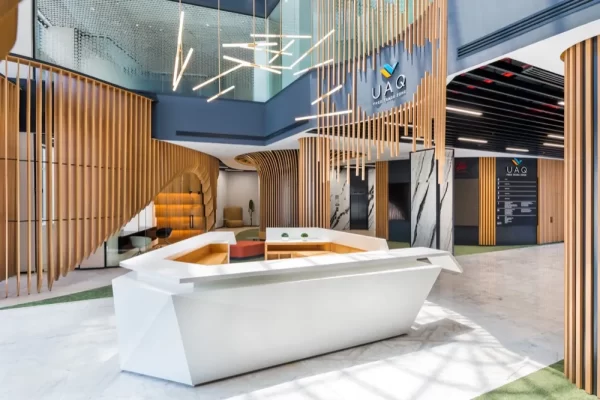BY THE NIUSTUDIO.COM
NIU is a multi-award-winning boutique architecture and design firm based in Dubai and founded as Studio Ati in 2001 by the Italian architect Giorgio Palermo. Architect Elena Gregorutti joined the practice as a partner in 2006. NIU evolved, as a division of Art Studio, after a strategic rebranding move. Both Giorgio and Elena, are driven by their passion for design, their unique eye for detail, quality, and perfection. Their distinctive approach is much valued by their clients who take pleasure in being a part of the creative process. Their clients are very pleased by the architects’ ability to listen to and interpret their wishes and requests.

This was the reason why the government of the Northern Emirate of Umm Al Quwain was looking forward to the realization of their project by Niu. They wanted a fresh, simple, and friendly environment with as many natural elements as possible to welcome stakeholders into the three main floors of the new the Umm Al Quwain Free Trade Zone Authority Headquarters. The design phase started in September 2020 and ended in May 2021, in the middle of the COVID-19 pandemic. Because of this, it was obvious that the design had to include specific details for the safety of the guests and the employees. The challenge was to create a stimulating, but visually appealing interior around the already existing massive structural columns that could allow for visitors to maintain their social distancing and comply with flow guidelines, within the limited space.
The architects’ immediately considered nature-inspired elements and so they decided to use wooden slats. Taking advice from the American Hardwood Export Council, American red oak was used to create louvres to conceal the structural columns, but also to provide discreet lighting and suggest separate areas while maintaining open sightlines. The remarkable centrepiece is a 3.5-metre-high organic element suggesting a massive, ancient tree. These impressive, suspended floor-to-ceiling organic shaped oak elements add drama and elegance to the area.
They also serve to create partitions and to divide the space but also to maintain an open-plan concept. Also, the louvred oak provides visual privacy and sound absorption. The customised seating area was constructed at the base of the tree trunk and spread about in comfortable pebble-shaped pouffes. The solid and veneered oak louvers were also used to add interest and dimension to the glass façades of the closed meeting rooms. The area is flooded with natural daylight due to the floor-to-ceiling, wall-to-wall windows on two sides. At the main entrance, the double height 8-metre-high ceiling of the main reception and information desk makes a bold statement in white Corian.
According to Giorgio: “In our projects we pay a lot of attention to the issue of sustainability, for this reason we like to consider this material for its qualitative aspects both from an aesthetic and technical point of view. A natural material capable of creating a visual and tactile relationship with the users of the space in which it is used. From the design point of view, in this specific project it was used to create elements of organic shape to emphasize the very origin of the material in nature.”
About why they chose to use American red oak, the architects said – “The particular natural color and veins of this species were selected and incorporated into the project since the concept design and it remained a characterizing element of the project, giving it a plus value highly appreciated by the customer and above all by the users of the space.”
For the flow management and to comply with COVID-19 guidelines, the white Carrera marble floor links the main entrance to the rear door and elevators. For contrast, some of the structural columns were rendered in ceramic. Another characteristic is a sustainable carpet made from recycled plastic bottles adds soundproofing and underfoot comfort to the seating areas. The earthy ambience stretches to the Mezzanine and first-floor levels where huge windows flood the interior with natural daylight. In the fifty square metre conference/multi-function room there are some chairs that replicate the slat motif, and as part of the natural ambiance, numerous plants are found. Finally, the walls are painted in shades of sky blue and green giving the whole space a very natural and calming ambiance.
About Red Oak
Red oak is the most dominant species in the U.S. hardwood forests with distinctive grain and wood that is not always red in colour. These trees grow only naturally and almost exclusively in North America, although they can be planted elsewhere. Forest Inventory Analysis (FIA) data shows that the red oak growing stock is 18.7% of total U.S. hardwood growing stock and that while 33.9 million m3 of American red oak are harvested each year, more than 32 million m3 are naturally growing over the same period. Generally, the sapwood of red oaks is light brown, and the heartwood is often pinkish to reddish brown. American red oaks have very good overall strength properties relative to weight and so its main uses are furniture, flooring, doors, and certain construction applications.
For this project, the amount of red oak that was used equals to 2 full 40-foot containers which is around 2,300 cubic feet. This means that 69.5 metric tons of CO2 were kept out of the atmosphere as part of carbon capture feature, and with a replacement rate in the US hardwood forest, through natural regeneration, of just 68 seconds.
About AHEC
The American Hardwood Export Council (AHEC) is an international trade association for the U.S. hardwood industry, representing exporters among U.S. hardwood companies and all the major U.S. hardwood production trade associations. AHEC runs a worldwide program to promote American hardwoods in over 50 export markets, concentrating on providing architects, specifiers, designers, and end-users with technical information on the range of species, products and sources of supply. In addition, AHEC also produces a full range of technical publications

